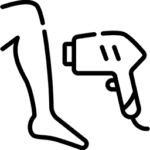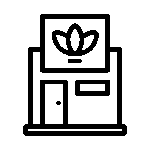Top Conversion Rate optimization Best Practices for 2025

In the competitive beauty industry, a stunning website is just the start. The real magic happens when visitors take action, whether that's booking a facial, purchasing a haircare product, or signing up for your newsletter. If your site gets plenty of traffic but fails to generate new clients, it’s not a traffic problem, it’s a conversion problem. The key to turning those casual browsers into loyal, paying clients lies in mastering conversion rate optimization (CRO).
This isn't about guesswork or complete redesigns. It's about making strategic, data-backed adjustments that guide visitors toward a specific goal. Think of your website as your digital front desk; it should be inviting, intuitive, and highly effective at securing appointments. To truly turn browsers into bookings, a fundamental understanding of how to improve website conversion rates and boost sales is essential for any beauty business. This guide provides a clear roadmap for doing just that.
We've cut through the noise to bring you nine actionable conversion rate optimization best practices tailored specifically for beauty professionals like you. From A/B testing your booking buttons to leveraging social proof with client testimonials, each point includes easy-to-follow instructions and practical examples. You will learn precisely how to implement these strategies to transform your website from a simple online brochure into a powerful, client-generating machine. Let’s dive in and start turning every click into a potential booking that grows your business.
1. A/B Testing and Multivariate Testing
The best way to improve your website is to stop guessing what works and start testing. A/B testing is a simple method to compare two versions of a webpage element to see which one gets more clients to book or buy. Think of it as a friendly competition between two button colors, headlines, or images to see which one performs best.
For example, you can test a "Book Now" button in your signature brand color against a high-contrast green one. You show the original button to half your visitors and the new green button to the other half. The version that gets more clicks is the clear winner, and you can confidently make that change permanent. This data-driven approach is at the heart of effective conversion rate optimization best practices.
Multivariate testing is a more advanced version where you test multiple changes at once, like a new headline, a different photo, and updated button text all at the same time. This is powerful but requires a lot of website traffic to get reliable results. For most business owners, starting with simple A/B tests is the most effective approach.
Actionable Implementation Steps
To get started, pick a high-impact page like your services page or booking portal and follow these steps:
- Define Your Goal: Decide on the one action you want more people to take. Do you want more clicks on the "Book an Appointment" button or more purchases of a new skincare line? Be specific.
- Form a Hypothesis: Create a simple "if-then" statement. For example: "If I change the 'Book Now' button color from light pink to bright green, then more people will click it because it will stand out more."
- Choose a Tool: Use free tools like Google Optimize (now part of Google Analytics 4) or user-friendly platforms like Optimizely or VWO. These tools handle the technical side of splitting your traffic and tracking the results for you.
- Run the Test & Analyze: Let the test run long enough to get meaningful results (usually a week or two, depending on your traffic). Once a winner is declared, implement the change and move on to your next test.
The infographic below illustrates the fundamental workflow for a simple, effective A/B test.
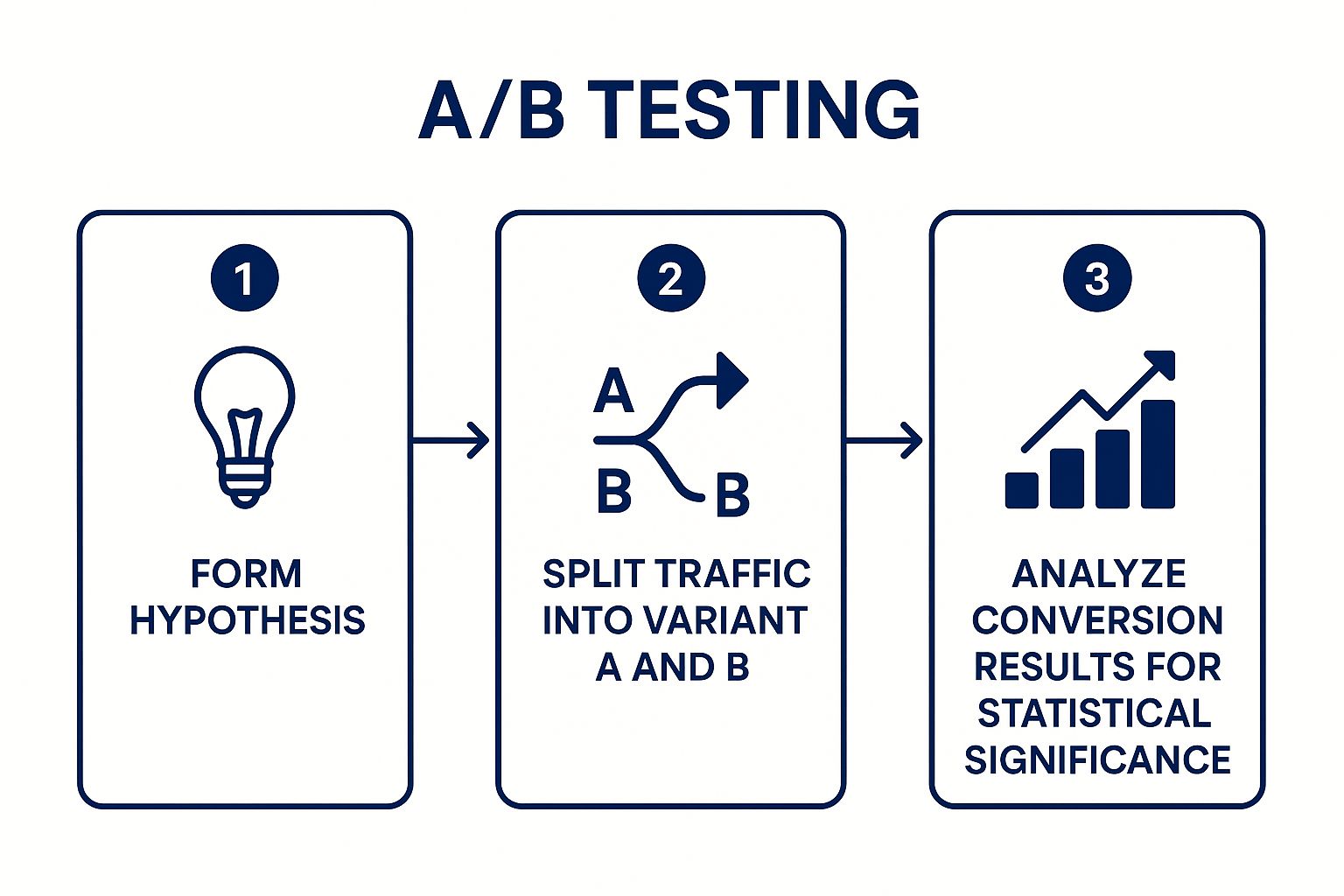
This process ensures every change you make is proven to improve your bottom line, taking the guesswork out of website updates.
2. Landing Page Optimization
A landing page is a special webpage created for a single purpose, like promoting a specific offer or service. When you run an ad on Instagram for a "New Client Balayage Special," you should send people to a dedicated landing page about that offer, not your general homepage. This is one of the most important conversion rate optimization best practices because it keeps potential clients focused and free from distractions.
A great landing page has one clear goal. For your balayage special, it would have a bold headline, persuasive text about the service, stunning before-and-after photos, and a very obvious button to book the appointment. By removing links to other services or blog posts, you create a direct path for the user to take the exact action you want them to.
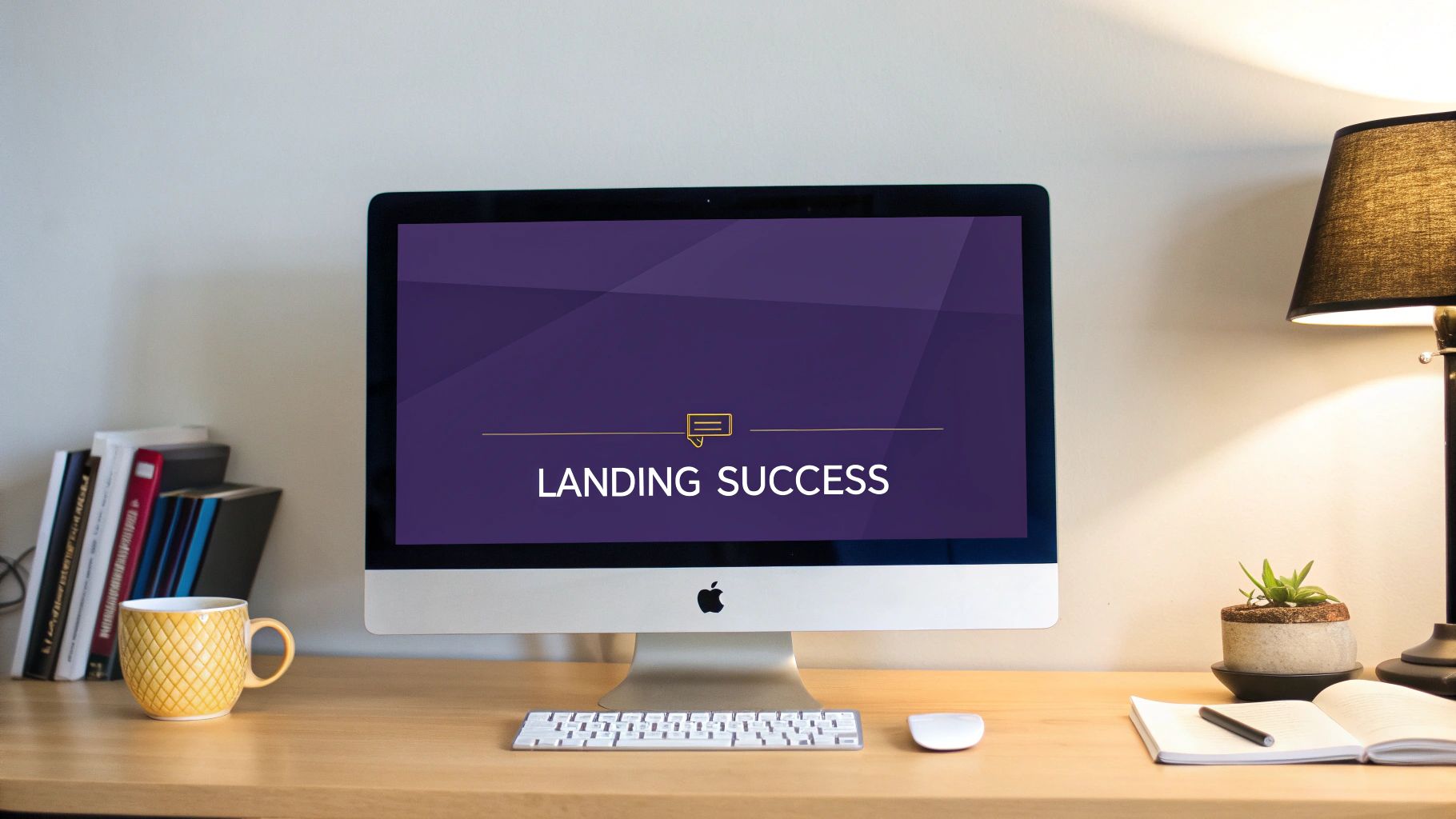
Actionable Implementation Steps
Here’s how business owners can start optimizing their landing pages for more bookings and sales:
- Match the Ad to the Page: Make sure your landing page headline and content perfectly match the ad the visitor clicked. If your ad promises a "20% Discount on First-Time Facials," the landing page must immediately show that same offer. Consistency builds trust.
- Keep Your Forms Simple: Long, complicated booking forms are a major reason people abandon the process. Only ask for the absolute essentials: name, email, and phone number. You can gather more details later. The goal is to make booking as quick and easy as possible.
- Add Trust Signals: Include testimonials, client photos (with permission), or star ratings directly on the page. Seeing that other people have had a great experience makes new visitors feel more confident about booking with you.
- Design for Mobile First: Most of your clients will find your landing page on their phones. Open the page on your own smartphone. Does it load quickly? Is the text easy to read without pinching and zooming? Are the buttons large enough to tap easily? If not, you are losing clients.
3. Call-to-Action (CTA) Optimization
Your call-to-action (CTA) is the button or link that tells your visitors what to do next, like "Book Now" or "Buy Product." It's the most important part of your page. A weak, unclear, or hidden CTA is a primary cause of lost conversions. Optimizing your CTAs is a core practice that can deliver immediate results.
The goal is to make your CTA so compelling and easy to find that a visitor has no doubt about their next step. Simple changes can have a huge impact. For example, changing a button's text from a generic "Submit" to a more exciting "Claim My 20% Off" creates urgency and shows value, making users more likely to click. For your salon, this could be the difference between a visitor leaving your site or becoming a new client.
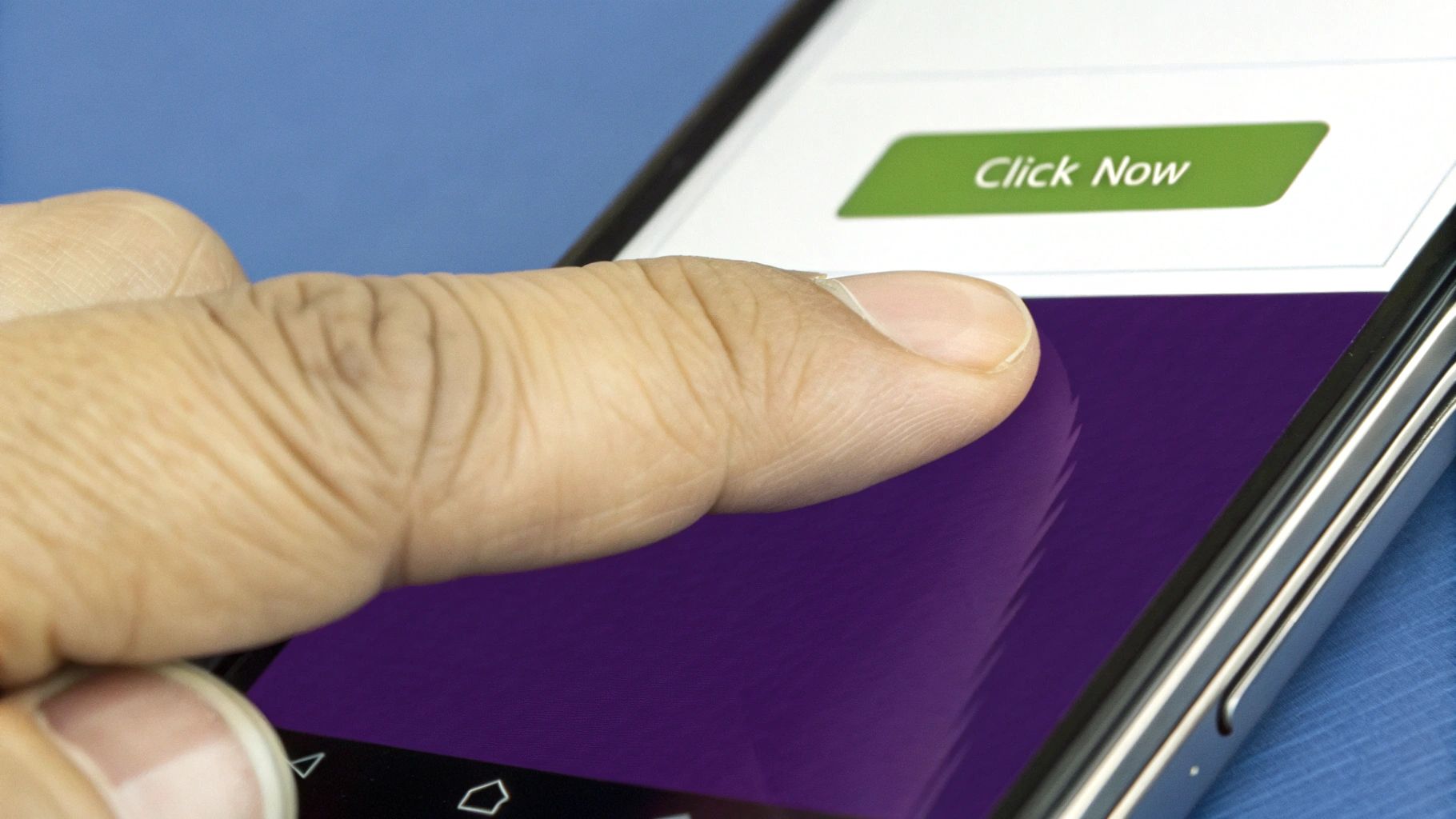
Actionable Implementation Steps
Review your main pages—like your services and booking pages—and use these steps to make your CTAs more effective:
- Use Strong, Action-Oriented Words: Replace passive phrases like "Learn More" with direct commands that promise a benefit. Try "View Our Services," "Book My Appointment," or "Get Glowing Skin." Using first-person language ("My") can often increase clicks because it gives the user a sense of ownership.
- Make It Stand Out Visually: Your CTA button should be impossible to miss. Use a bold color that contrasts with your website's background but still fits your brand. Make the button large enough to be easily seen and tapped, especially on a mobile phone.
- Position It Logically: Place your CTA where a visitor's eyes naturally go. This is typically "above the fold" (visible without scrolling) and at the end of a service description, right after you've convinced them of the value.
- Create a Sense of Urgency (When Appropriate): Phrases like "Book Now to Secure Your Spot" or "Limited-Time Offer" can encourage immediate action. Use this tactic honestly to avoid sounding spammy.
4. Social Proof Integration
When a potential client is considering booking with you for the first time, their biggest question is, "Can I trust this business?" The best way to answer that is by showing them that other people already do. This is social proof, and it's one of the most powerful conversion rate optimization best practices for building instant credibility.
Social proof works by leveraging a simple psychological principle: people are more likely to do something if they see others doing it. For your beauty business, this can include client testimonials, before-and-after photos, star ratings, or even a small notification that says, "5 appointments booked today." By showcasing happy clients, you reduce the perceived risk for new visitors and make them feel more confident in their decision to book with you.
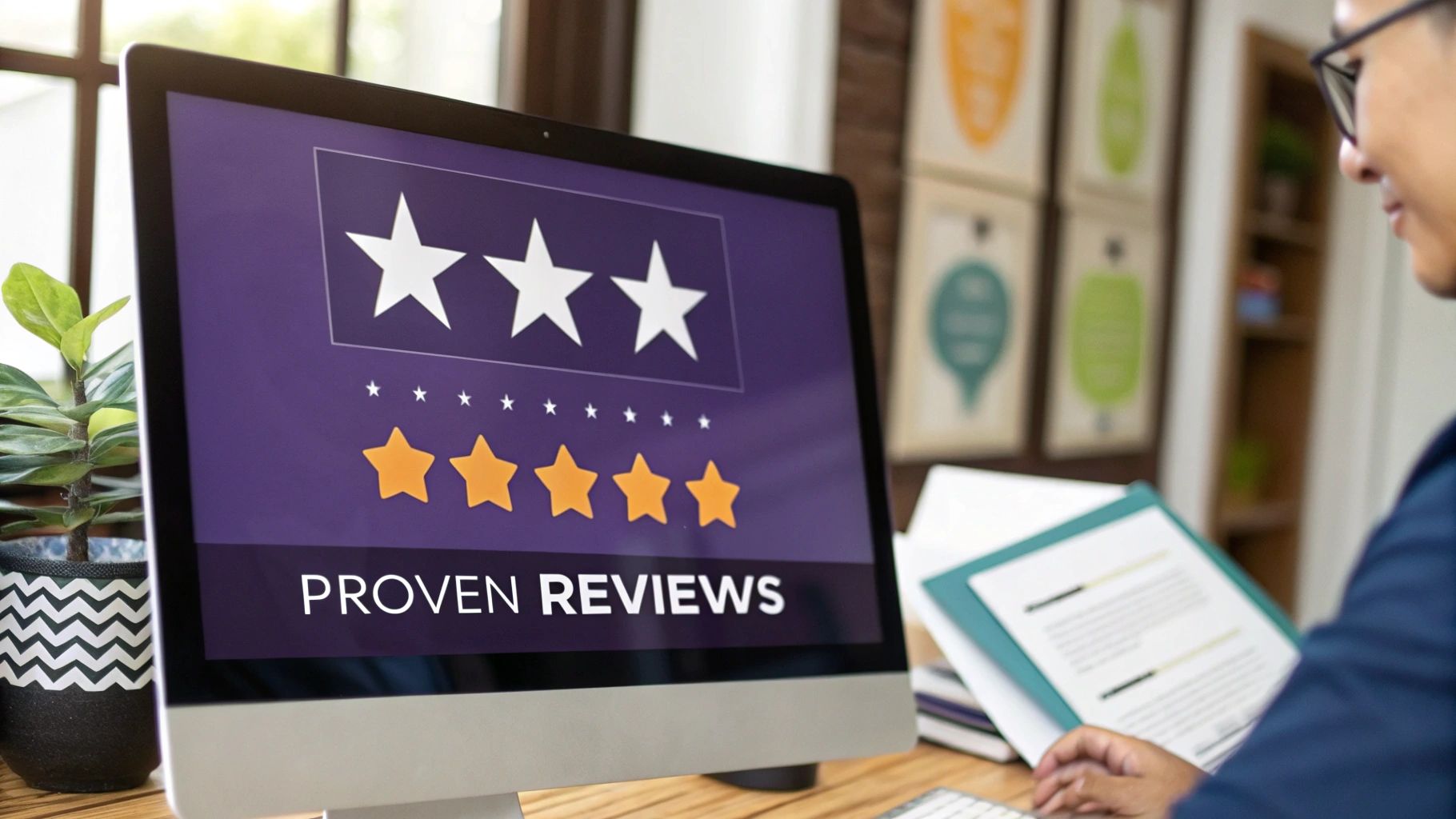
Actionable Implementation Steps
Start integrating social proof on the pages where clients make decisions, such as your services pages, booking portal, and homepage.
- Automate Review Collection: Set up an automated email or text message that goes out to clients a day after their appointment, asking them to leave a review. Provide a direct link to your Google Business Profile, Yelp page, or website to make it as easy as possible.
- Feature Before-and-After Photos: Visual proof is everything in the beauty industry. Create a gallery or "Lookbook" on your website with high-quality before-and-after photos (always get client permission first!). Place relevant photos directly on your service pages—showcase your best balayage work on the balayage service page.
- Sprinkle Testimonials Everywhere: Don't just hide your best reviews on a testimonials page. Place a powerful client quote directly next to the "Book Now" button for the relevant service. Including the client's name and photo (with permission) makes the testimonial even more believable. You can find more ideas for using client content in this guide to social media marketing for beauty salons on gohappybeauty.com.
5. Page Load Speed Optimization
If your website takes more than three seconds to load, you are losing clients. It's that simple. In an age of instant gratification, a slow website is one of the biggest conversion killers. Page load speed optimization is the process of making your website as fast as possible, which is crucial for keeping impatient visitors engaged and moving toward the booking button.
Think about your own online behavior. If a page is slow, you hit the "back" button and find another option. Your potential clients are no different. For a beauty business with a site full of high-quality images, speed is especially important. A fast website not only leads to more conversions but also ranks better on Google, making it a critical aspect of conversion rate optimization best practices.
Actionable Implementation Steps
You don't need to be a tech wizard to improve your site speed. Here are three practical steps business owners can take:
- Compress Your Images: High-resolution photos of your work are essential, but they can be very large files that slow down your site. Before uploading any image, run it through a free online tool like TinyPNG. It will dramatically reduce the file size without any noticeable loss in quality. This is the single most effective thing you can do to speed up your site.
- Enable Browser Caching: Caching allows a visitor's browser to save parts of your website (like your logo and background images). When they visit your site again, it loads much faster because it doesn't have to re-download everything. If you use WordPress, you can easily enable this with a free plugin like W3 Total Cache or LiteSpeed Cache.
- Invest in Good Hosting: Budget website hosting is often slow and unreliable because you share resources with thousands of other websites. If your site is consistently slow, consider upgrading your hosting plan or switching to a reputable provider known for speed. This is the foundation of a fast website.
6. Mobile Optimization and Responsive Design
Today, your website is more likely to be viewed on a smartphone than on a desktop computer. Mobile optimization is no longer optional; it's one of the most vital conversion rate optimization best practices. A responsive design ensures that your website automatically adjusts its layout to look great and work perfectly on any screen size, from a small phone to a large monitor.
For a beauty business, this is critical. Imagine a potential client trying to book an appointment on their phone. If the text is too small, the buttons are hard to tap, or the booking form is frustrating to fill out, they will give up and find a competitor with a mobile-friendly site. A poor mobile experience is like having a front door to your salon that is difficult to open—it turns away potential customers before they even step inside.
A seamless mobile experience directly translates to more bookings and revenue. It ensures you capture business from clients whether they're at home on their laptop or looking for a last-minute appointment while out and about.
Actionable Implementation Steps
Take out your phone and navigate to your own website. Be honest about the experience. Then, take these steps to improve it:
- Test Your Buttons: Can you easily tap every button and link with your thumb without accidentally hitting something else? Make sure all clickable elements are large, well-spaced, and easy to interact with.
- Simplify Navigation: Your mobile menu should be clean and simple. Prioritize the most important pages, like "Services," "Book Now," and "Contact." A visitor should be able to find what they need in two taps or less.
- Streamline Your Forms: Filling out forms on a phone can be tedious. Keep your mobile booking and contact forms as short as possible. Use features like dropdown menus and checkboxes to minimize typing. Only ask for the information you absolutely need to secure the booking.
- Use Google's Mobile-Friendly Test: This free tool will analyze your website and tell you if it meets Google's standards for mobile usability. It will also provide specific recommendations for what to fix.
7. Personalization and Dynamic Content
Personalization is about making your website feel like it was designed specifically for each visitor. It's a powerful conversion rate optimization strategy that goes beyond a generic, one-size-fits-all experience. By showing different content or offers based on a user's behavior, location, or history with your business, you can create a more relevant journey that leads directly to a booking.
Imagine a client who has previously booked a facial visits your website. Instead of seeing the standard homepage, they're greeted with a banner that says, "Welcome back! Time for your next glow-up? Book your facial now and get a complimentary hydrogel mask." This is dynamic content in action. It makes the client feel recognized and understood, dramatically increasing the chances they'll book again.
This is the same principle used by giants like Amazon ("Recommended for you") and Netflix. For your beauty business, it could mean showing a special offer for lash fills only to clients who have booked that service before, or promoting your bridal makeup services to visitors who have spent time on that page.
Actionable Implementation Steps
You can start with simple personalization tactics and build from there:
- Target New vs. Returning Visitors: This is the easiest place to start. Create a special pop-up or banner that only appears for first-time visitors, offering them 10% off their first service. This provides an immediate incentive to book.
- Use Geotargeting: If you have multiple salon locations, use the visitor's location to automatically show them information for the branch nearest to them. This removes the friction of having to search for the right location.
- Personalize Email Campaigns: Use your client's name in the subject line and body of your emails. More advanced tactics include sending targeted promotions based on their past services. For example, send a "Rebook Now" reminder to all clients who had a gel manicure four weeks ago.
- Leverage Your Booking Software: Many modern booking systems have features that allow for basic personalization. Explore your software's settings to see if you can set up automated, personalized reminders and follow-ups.
8. User Experience (UX) and Design Psychology
A great website doesn't just look good; it feels good to use. User Experience (UX) and design psychology focus on creating a website that is intuitive, easy to navigate, and persuasive. This approach uses an understanding of how people think and behave online to guide them smoothly from their first click to a completed booking.
For example, using plenty of white space around your "Book Now" button makes it stand out and appear more important. Organizing your services into clear, logical categories (e.g., "Haircuts & Styling," "Color Services," "Treatments") reduces "cognitive load," meaning visitors don't have to think too hard to find what they're looking for. By applying these principles, you make the decision to book feel easy and natural, which is a key goal of conversion rate optimization best practices.
Actionable Implementation Steps
Review your key pages through the eyes of a new client and apply these psychological design principles:
- Create a Clear Visual Path: Use size, color, and placement to direct your visitor's attention. Your most important element (like your main call-to-action) should be the most visually dominant thing on the page. Guide the user's eye naturally toward the action you want them to take.
- Simplify Choices: Don't overwhelm visitors with too many options at once. This is known as the "paradox of choice." Instead of listing 30 different facials on one page, group them into categories like "Anti-Aging," "Acne-Fighting," and "Hydrating" to make the decision process easier.
- Use High-Quality, Authentic Imagery: People connect with faces. Use professional photos of your actual salon, your team, and your real clients (with permission). This builds trust far more effectively than generic stock photos. For more tips on effective visuals, explore these website design best practices.
- Ensure Readability: Use a clean, easy-to-read font and break up long blocks of text with headings, bullet points, and images. Your service descriptions should be scannable, allowing visitors to quickly find the information they need.
9. Analytics and Data-Driven Decision Making
The only way to truly know if your website is working is to track the data. Analytics and data-driven decision-making form the foundation of all conversion rate optimization best practices. Instead of making changes based on a hunch or what you think your clients want, you use real data to understand how people are actually interacting with your site.
This means looking beyond simple metrics like how many people visited your site. It involves understanding which pages they visit, how long they stay, where they click, and—most importantly—where they leave. For example, your analytics might reveal that many people visit your "Lash Extensions" page but very few click the "Book Now" button. This is a clear signal that something on that page is preventing them from taking the next step, giving you a specific problem to solve.
Using free tools like Google Analytics 4 (GA4) allows you to stop guessing and start making strategic improvements that are proven to increase bookings and sales.
Actionable Implementation Steps
Get comfortable with your data by focusing on a few key actions:
- Set Up Conversion Tracking: This is the most important step. In Google Analytics, define a "conversion" as a completed booking or a submitted contact form. This allows you to see exactly which pages and marketing efforts are generating actual business, not just traffic.
- Identify Your Top "Exit Pages": Look at your data to see which pages people most often leave your site from. If your booking confirmation page is a top exit page, that's great! If it's the first step of your booking process, you have a problem that needs immediate attention.
- Know Where Your Best Clients Come From: Use your analytics to see which channels (e.g., Instagram, Google, email newsletter) are sending you the clients who actually book appointments. This tells you where to focus your marketing efforts for the best return.
- Schedule a Monthly Data Check-In: Set aside 30 minutes each month to review a simple dashboard of your key metrics: total conversions, conversion rate, and top traffic sources. This keeps you focused on what's working and what isn't, helping you make smarter decisions that improve your beauty salon profit margins.
Conversion Optimization Practices Comparison
| Item | Implementation Complexity 🔄 | Resource Requirements ⚡ | Expected Outcomes 📊 | Ideal Use Cases 💡 | Key Advantages ⭐ |
|---|---|---|---|---|---|
| A/B Testing and Multivariate Testing | Moderate to High | Requires significant traffic and tools | Data-driven ROI improvements, risk mitigation | Testing variations for optimization | Eliminates guesswork, measurable impact |
| Landing Page Optimization | Moderate | Design & copywriting resources | Higher conversion rates, improved UX | Focused campaigns, increasing conversions | Better ad spend ROI, campaign performance |
| Call-to-Action (CTA) Optimization | Low to Moderate | Minimal; mostly design and testing | Quick conversion rate improvements | Buttons, links, and prompts optimization | Easy to test, direct impact on clicks |
| Social Proof Integration | Low to Moderate | Content creation and management | Increased trust and conversions | Builds credibility, reduces anxiety | Authentic perspectives, objection handling |
| Page Load Speed Optimization | High | Technical expertise and tools | Reduced bounce, improved conversions | Speed-sensitive websites and mobile | SEO boost, better UX, cost reductions |
| Mobile Optimization and Responsive Design | Moderate to High | Development & extensive testing | Increased mobile conversions & engagement | Mobile-first strategies | Captures mobile traffic, SEO improvement |
| Personalization and Dynamic Content | High | Data collection, technical setup | Higher engagement and conversion rates | Tailored user experiences | Enhanced loyalty, improved lifetime value |
| User Experience (UX) and Design Psychology | Moderate | UX research and design expertise | Sustainable conversion improvements | User-centered design optimization | Builds trust, reduces cognitive load |
| Analytics and Data-Driven Decision Making | Moderate to High | Technical setup and ongoing analysis | Clear ROI, continuous optimization | Data-informed CRO decisions | Eliminates guesswork, strategic insights |
Start Your Beauty Business's Transformation Today
You've just navigated a comprehensive roadmap of conversion rate optimization best practices, each one a powerful tool in your digital toolkit. We've explored everything from the scientific precision of A/B testing and the magnetic pull of a well-crafted call-to-action to the silent, yet crucial, impact of page load speed and mobile-first design. For beauty professionals like estheticians, lash artists, and salon owners, these strategies are not just technical adjustments; they are the bridge between your online presence and a booked-out calendar.
Mastering these techniques transforms your website from a simple digital brochure into your most effective, round-the-clock salesperson. It's about creating an online experience that mirrors the personalized, high-touch service you provide in your studio or salon, guiding potential clients from curiosity to confident booking.
From Insights to Action: Your Next Steps
The journey to a high-converting website begins with a single, deliberate step. Instead of feeling overwhelmed by the nine distinct areas we've covered, focus on a structured, iterative approach. This is the core principle behind successful conversion rate optimization best practices: small, consistent improvements yield exponential results over time.
Here is a practical, three-step plan to get started immediately:
-
Conduct a Quick Audit: Begin with the low-hanging fruit. Use a free tool like Google's PageSpeed Insights to check your site's mobile and desktop performance. Is your primary call-to-action button ("Book Now," "Schedule a Consultation") immediately visible without scrolling on your homepage? Do you have at least 2-3 client testimonials or reviews prominently displayed? Identifying these initial gaps gives you a clear starting point.
-
Focus on One Core Area: Choose one strategy from this article to master first. If you have traffic but low booking rates, start with A/B testing your CTAs. Change the button color, text, or placement and measure the results for two weeks. If you receive many questions about your services, focus on landing page optimization by adding a detailed FAQ section or a before-and-after gallery.
-
Leverage Your Analytics: The most crucial takeaway is to let data drive your decisions. Spend 30 minutes this week in your Google Analytics or website dashboard. Identify your most visited page. Now, ask yourself: what is the single action I want a user to take on this page, and how can I make that action clearer and easier to complete? This simple question is the foundation of data-driven CRO.
Embracing a Culture of Continuous Improvement
Ultimately, optimizing your website is not a one-and-done project. It is a continuous cycle of listening to your audience, testing your hypotheses, and refining the user experience. Each test you run, every piece of data you analyze, and every design tweak you implement brings you closer to understanding what truly motivates your ideal client.
By embracing these conversion rate optimization best practices, you are investing directly in the growth and sustainability of your beauty business. You're not just getting more clicks; you're building trust, fostering loyalty, and creating a seamless digital pathway that turns online visitors into your biggest fans and most devoted clients. The power to transform your online performance is in your hands, and the journey starts now.
Ready to implement these powerful strategies without the technical hassle? The gohappybeauty platform is designed specifically for beauty professionals, with built-in features for high-speed performance, mobile optimization, and conversion-focused design, allowing you to get found online and turn visitors into loyal clients. Start building your high-converting beauty website today with gohappybeauty.
Grow your beauty business
Our focus is, and always will be, helping you improve your online presence and generate more business from your website. That is what we do, for you.
